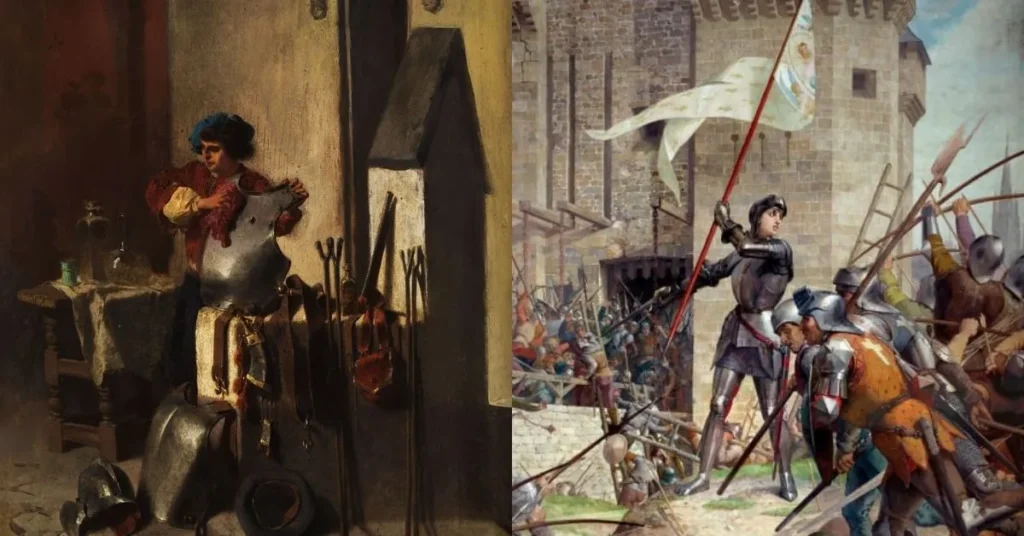The life of a medieval squire marked the final stage before achieving knighthood after a boy had served as a Page. A page could become a squire around the age of 13 after demonstrating loyalty and satisfactory performance as a Page. This rank was the stage where the training to become a knight really intensified.
Medieval Squire Training
A medieval squire received training and education from a lord in order to advance toward knighthood. The main part of the education included mastering the code of chivalry, along with skills in horsemanship, swordsmanship, and marksmanship.

Squires learned the rules of nobility and athletic abilities crucial for the battlefield. Swordsmanship complemented by shield usage was a focal point along with their ability to wield a lance. Beyond combat, a squire was also expected to be versed in music, dance, jousting, and court etiquette.
Training extended to castle defense and siege warfare. The squire’s training covered all aspects of battle to help mold them into skilled, well-rounded fighters, paving the way for potential knighthood.
Squires were meticulously educated in the code of chivalry. Epic tales and stories were employed as powerful teaching tools, weaving moral lessons into narratives that illustrated the importance of adhering to the code.
This code, a moral and ethical framework, demanded more than just martial prowess from knights; it emphasized virtues such as honor, courtesy, bravery, and mercy towards the less fortunate.
Duties of a Medieval Squire
A medieval squire shouldered several duties integral to their training and the support of their assigned knight. It was the second stage of becoming a knight.
These young boys undertook essential tasks, including the preparation and maintenance of a knight’s gear, including armor, shield, and sword. Regular chores involved scrubbing armor to ensure its cleanliness and longevity.
Squires were given the responsibility to care for and manage the knight’s horses, even replacing those injured or killed in action. Their duties extended to guarding prisoners, accompanying knights to tournaments and battlefields, and dressing them in armor.
A squire’s role also encompassed symbolic and protective aspects, such as carrying the knight’s flag into battle and ensuring the knight’s safety. The squires were also expected to make sure an honorable burial was given in case of a knight’s death.
Medieval Squire Equipment and Armor
Medieval squires were distinguished by the clothing they wore, marked by specific designs and colors associated with the knights they served. These clothes not only identified their affiliation but also reflected their connection to their knight’s household.
Squires armed themselves with swords and shields. The capability to skillfully wield these weapons not only demonstrated martial skills but also increased their chances of becoming a knighthood.
Squires used a simple sword or lance during training or battle and accompanied their lords during wars. However, they were not expected to engage in direct combat during battles as they were not considered fully trained warriors.
The Dubbing Ceremony
As the squire approached 21, their lord judged and determined eligibility for knighthood after years of dedicated service and training. The dubbing ceremony marked the official transition boy from the rank of a squire to a knight.
It typically occurred around the age of 21 but sometimes also happened early if a medieval squire had performed exceptional acts of bravery. The ceremony initially involved a simple gesture, a lord delivering an open-handed blow to the back of the squire’s neck while asking him to abide by the code of chivalry.
As the influence of Christianity grew on the knightly culture, the ceremony evolved. The squire underwent a ritualistic bath, followed by a night of vigil at the Castle Chapel.
The next day, a sermon took place before the pivotal moment where the lord, accompanied by two sponsors, presented a sword and shield to the squire. The dubbing itself involved a tap with either the lord’s hand or the sword.
Also Read: 5 Famous Spanish Knights Who Became Figures Of Legend
